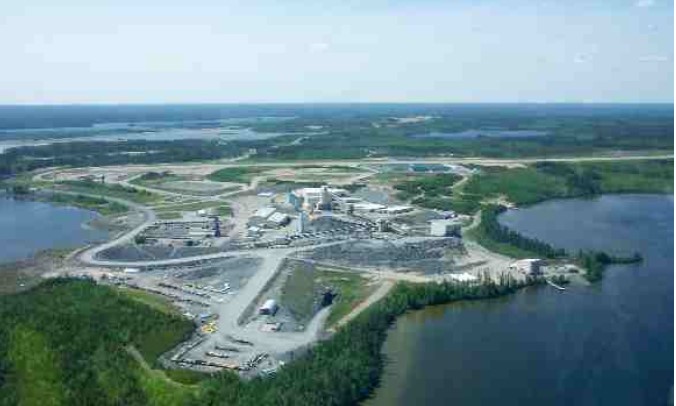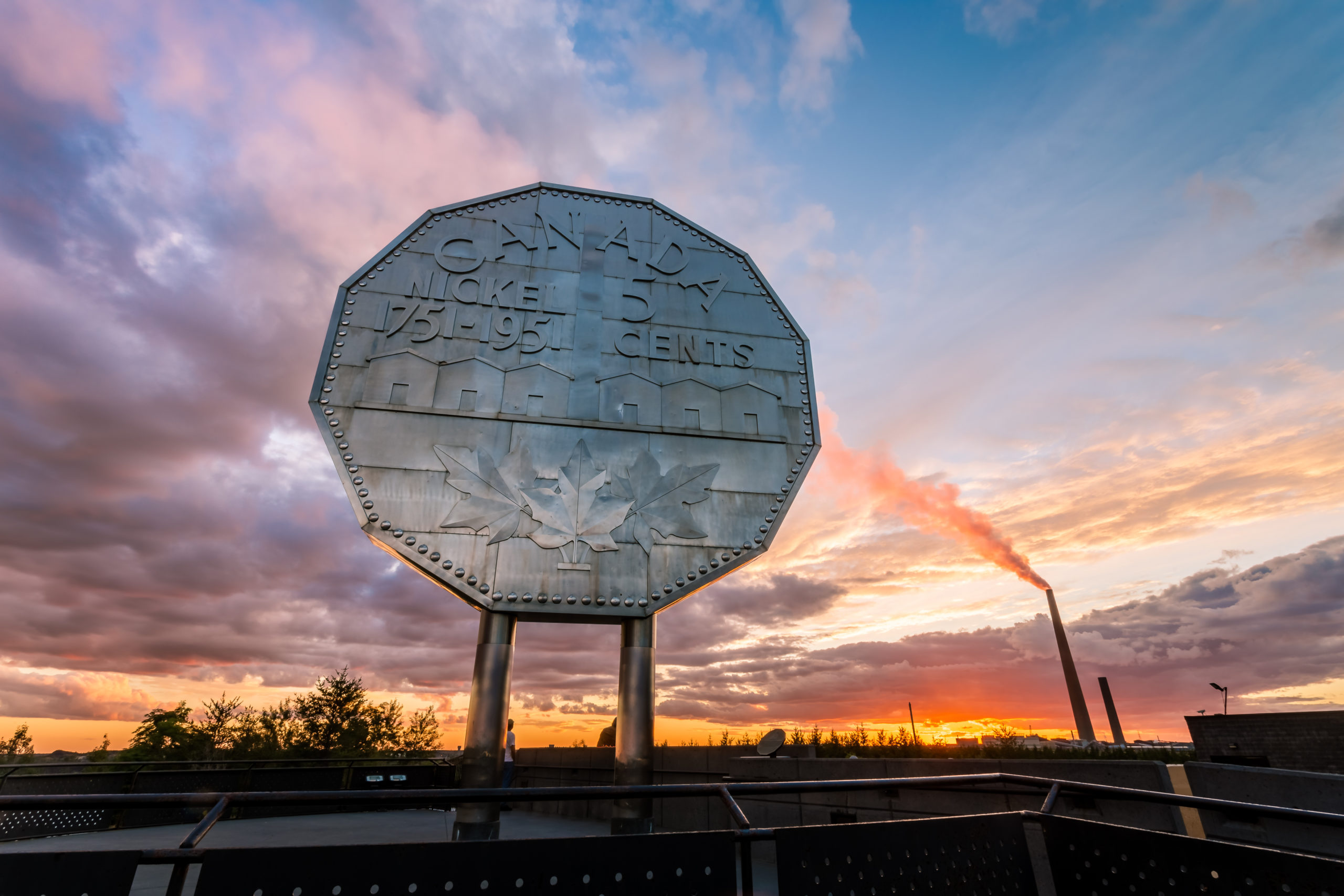Hemlo Shines
Barrick Gold Corporation’s Hemlo mines are located about a 30-minute drive east of the Town of Marathon on the north shore of Lake Superior 350 km east of Thunder Bay.
The mines (David Bell and Williams), are also about 1000 km from Barrick’s head office at the corner of Bay and Front Streets in the heart of Canada’s financial district in Toronto. To put that distance into perspective, Hemlo is about a 12-hour drive (on a good day) northwest from the company’s front door. Anyone driving to the site from Toronto either turns north on Yonge Street, one block from Barrick’s head office, and takes the world’s longest road almost directly to the mines; or, they could just as easily turn south and be almost half way to Florida in about the same amount of time. In all seriousness, compared to the company’s other properties scattered around the world, Hemlo is within relatively easy reach of Barrick’s head office and is often referred to around the office as the company’s “local” operation. In fact, it’s not only Barrick’s “local” operation; it’s the company’s only operation in Canada.
Since the mines’ birth in 1985, the Hemlo property has been an outstanding producer and, even as it approaches its 26th year of operation, Hemlo is still of great value to Barrick.
“We are very proud of our Hemlo operation, which continues to generate profits after more than 25 years of operation,” says Kelvin Dushnisky, Barrick’s Executive Vice President of Corporate and Legal Affairs. “Hemlo’s commitment to high standards of social and environmental performance reflect Barrick’s values and has helped the company forge strong relationships with local communities. The operation is a model of good practice.”
The Hemlo operation has expanded its reserve base in each of the last two years, while continuing to produce more than 225,000 ounces of gold per year. It’s this kind of performance that has helped extend the life of the operation, which has long been a positive presence in the region. Indeed, the Hemlo mines and their owners have been good corporate citizens for more than a quarter of a century, and during much of that time they have been the only active mines to support the towns of Marathon, Manitouwadge, White River, and the Pic River and Pic Mobert First Nation communities.
The word “owners” was used above because Hemlo was previously a joint venture with Teck Resources until Barrick bought out its 50 per cent interest in April 2009. Nearly a year later, Barrick took complete control of the Hemlo property, acquiring Newmont Mining Corporation’s dormant Golden Giant mine (minus the tailings facility and the landfill area) in 2010. The last skip of ore was hoisted to surface at Golden Giant in January 2006, while gold recovery from the milling unit operations ceased about a month later. All mining infrastructure was removed from site by a third party in 2010.
Since then, the remaining mines on the property have continued to make adjustments to keep pace with the technical demands of modern mining. For example, in addition to adding new machinery and processing equipment to the operations, Barrick has concentrated on everything from implementing and training its employees on Oracle software, to integrating its own information systems, to achieving certification under the International Cyanide Management Code.
Also, in keeping with its corporate and social responsibilities, a high priority has also been placed on safety and environmental issues, particularly in the area of water management and the drawing of water from natural sources. In fact, instead of drawing on fresh water from area lakes and rivers, the company uses other sources of water as much as possible, such as storm water runoff captured in its open pit areas and from dewatering activities. A recently installed Actiflo water treatment system now brings these sources of water back to a processing tank at the site. As a result, the mines are using only 10 per cent of the water allowed by their current permits.
From day one, part of Barrick’s business plan has been to return the Hemlo site as close to its original state as possible. The company is proud that its on-going environmental work, which includes an annual re-vegetation and tree planting program, is being recognized not only locally, but on a national level too.
For instance, Barrick recently received a “Towards Sustainable Mining” (TSM) Leadership Award from the Mining Association of Canada, recognizing the company for its work at Hemlo in the areas of tailings management, energy use and greenhouse gas emissions, external outreach, and crisis-management planning.
Roger Souckey, Superintendent of Employee Relations at Hemlo, said the company is especially proud of the Leadership Award because Barrick is only the second company to win it since the TSM awards were inaugurated in 2006.
“We are very proud to see our Hemlo operation recognized as a leader in responsible mining by Canada’s mining industry, and we are particularly pleased that our external outreach efforts are being recognized,” he says.
As mentioned earlier, Barrick’s commitment to Corporate Social Responsibility, (CSR) involves working with and supporting local communities, including two First Nations communities, three municipalities and a national park. Barrick also partners with local organizations and institutions on programs to benefit the region and organizes Student Mining Days designed to bring mining information and technology to area schools.
The mine has developed constructive relationships with the Pic River and Pic Mobert First Nation communities and established socio-economic agreements to generate opportunities associated with the operation to its First Nations neighbours.
“The agreements provide for skills training for present and future mining opportunities, through a partnership with Confederation College in Thunder Bay, as well as support for the development of First Nations-led businesses and environmental monitoring and stewardship,” says Souckey, noting that about 10 per cent (60 people) of Hemlo’s workforce, comes from local Aboriginal communities.
As Barrick continues to search for more gold deposits, Souckey says the company believes it is even more important to engage in regular meetings with stakeholders by holding site-update meetings at least three times a year.
While winning awards and supporting local communities are noteworthy, the underlying story behind Hemlo’s success is based on safe production and controlling costs from the David Bell and Williams mines.
Mining techniques, naturally, play a big role in Hemlo’s success story because the two mines share milling, processing and tailings facilities as a means of controlling costs. Ore from the two mines is also co-mingled and fed to a standard grind, leach and carbon-in-pulp extraction mill to help ensure production costs are carefully controlled.
Hemlo General Manager Andrew Baumen says that gold ore is mined at the operation using two quite different mining methods: long-hole stoping and the Alimak mining method. Both methods are well suited for the meta-sedimentary/volcanic rock that hosts the gold ores in the Marathon District where Hemlo is located.
“Conventional long-hole stoping uses remote mucking equipment working in 20 to 25-metre-high retreats and 15 to 20 metres along strike, with an average ore width of three to seven metres,” Baumen says. “Long-hole traverse primary and secondary stopes are typically 25 metres high, 17 to 23 metres along strike, and up to 15 metres wide, with production drilling being handled by In-The-Hole drills, Stopmasters, or Solo drills (top hammer drills) that drill either 4.4 inch or 3.0 inch holes.”
The second mining method, the Alimak method, is very specialized, and Baumen says the company uses Manroc Developments Inc. of Manitou
wadge (located at the north end of Highway 614, 330 km east of Thunder Bay) to perform the stoping. According to Baumen, Hemlo is now a world leader in the Alimak mining method, having continually improved and refined the technique over the years.
All raise development, raise support, cable bolting, production drilling and blasting are performed by Manroc miners because of the unique skills required. The Alimak method involves developing a three-metre-square raise along the hanging wall of the ore body and, once that is established, steel screening is added on the walls for the length of the rise, Baumen says.
“It’s a tricky operation that requires cable bolts being drilled and installed in the hanging wall of the raise for dilution control,” Baumen says. “Production rings are also drilled from inside the raise to the foot-wall and hanging-wall contacts and stope boundaries, and they are blasted in sets, working from the bottom of the stope upwards.”
Swell is also mucked during the blasting cycles to create approximately 20 to 30 per cent of the stope tonnage, and the remaining broken muck is used to support the hanging-wall during the blasting cycle, Baumen adds. When all rings have been blasted, all remaining ore is removed from the stope.
While it is a mature operation, Hemlo has proven to be a property of interest to Barrick, as evidenced by the growth of its reserve base, since the company assumed 100 per cent ownership of the mines.
Barrick still has great faith in its lone Canadian property, and by all indications it will be many more years before the sun sets on Hemlo.





Comments